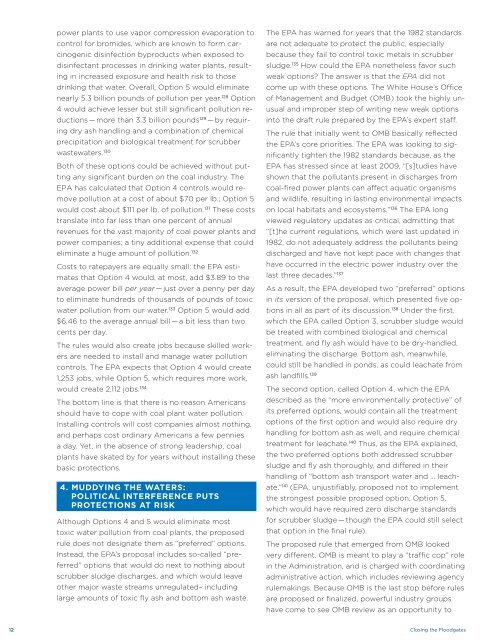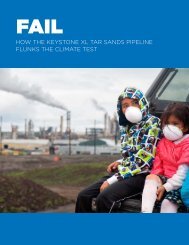CLOSING THE FLOODGATES: - Sierra Club
CLOSING THE FLOODGATES: - Sierra Club
CLOSING THE FLOODGATES: - Sierra Club
You also want an ePaper? Increase the reach of your titles
YUMPU automatically turns print PDFs into web optimized ePapers that Google loves.
power plants to use vapor compression evaporation tocontrol for bromides, which are known to form carcinogenicdisinfection byproducts when exposed todisinfectant processes in drinking water plants, resultingin increased exposure and health risk to thosedrinking that water. Overall, Option 5 would eliminatenearly 5.3 billion pounds of pollution per year. 128 Option4 would achieve lesser but still significant pollution reductions— more than 3.3 billion pounds 129 — by requiringdry ash handling and a combination of chemicalprecipitation and biological treatment for scrubberwastewaters. 130Both of these options could be achieved without puttingany significant burden on the coal industry. TheEPA has calculated that Option 4 controls would removepollution at a cost of about $70 per lb.; Option 5would cost about $111 per lb. of pollution. 131 These coststranslate into far less than one percent of annualrevenues for the vast majority of coal power plants andpower companies; a tiny additional expense that couldeliminate a huge amount of pollution. 132Costs to ratepayers are equally small: the EPA estimatesthat Option 4 would, at most, add $3.89 to theaverage power bill per year — just over a penny per dayto eliminate hundreds of thousands of pounds of toxicwater pollution from our water. 133 Option 5 would add$6.46 to the average annual bill — a bit less than twocents per day.The rules would also create jobs because skilled workersare needed to install and manage water pollutioncontrols. The EPA expects that Option 4 would create1,253 jobs, while Option 5, which requires more work,would create 2,112 jobs. 134The bottom line is that there is no reason Americansshould have to cope with coal plant water pollution.Installing controls will cost companies almost nothing,and perhaps cost ordinary Americans a few penniesa day. Yet, in the absence of strong leadership, coalplants have skated by for years without installing thesebasic protections.4. MUDDYING <strong>THE</strong> WATERS:POLITICAL INTERFERENCE PUTSPROTECTIONS AT RISKAlthough Options 4 and 5 would eliminate mosttoxic water pollution from coal plants, the proposedrule does not designate them as “preferred” options.Instead, the EPA’s proposal includes so-called “preferred”options that would do next to nothing aboutscrubber sludge discharges, and which would leaveother major waste streams unregulated– includinglarge amounts of toxic fly ash and bottom ash waste.The EPA has warned for years that the 1982 standardsare not adequate to protect the public, especiallybecause they fail to control toxic metals in scrubbersludge. 135 How could the EPA nonetheless favor suchweak options? The answer is that the EPA did notcome up with these options. The White House’s Officeof Management and Budget (OMB) took the highly unusualand improper step of writing new weak optionsinto the draft rule prepared by the EPA’s expert staff.The rule that initially went to OMB basically reflectedthe EPA’s core priorities. The EPA was looking to significantlytighten the 1982 standards because, as theEPA has stressed since at least 2009, “[s]tudies haveshown that the pollutants present in discharges fromcoal-fired power plants can affect aquatic organismsand wildlife, resulting in lasting environmental impactson local habitats and ecosystems.” 136 The EPA longviewed regulatory updates as critical, admitting that“[t]he current regulations, which were last updated in1982, do not adequately address the pollutants beingdischarged and have not kept pace with changes thathave occurred in the electric power industry over thelast three decades.” 137As a result, the EPA developed two “preferred” optionsin its version of the proposal, which presented five optionsin all as part of its discussion. 138 Under the first,which the EPA called Option 3, scrubber sludge wouldbe treated with combined biological and chemicaltreatment, and fly ash would have to be dry-handled,eliminating the discharge. Bottom ash, meanwhile,could still be handled in ponds, as could leachate fromash landfills. 139The second option, called Option 4, which the EPAdescribed as the “more environmentally protective” ofits preferred options, would contain all the treatmentoptions of the first option and would also require dryhandling for bottom ash as well, and require chemicaltreatment for leachate. 140 Thus, as the EPA explained,the two preferred options both addressed scrubbersludge and fly ash thoroughly, and differed in theirhandling of “bottom ash transport water and … leachate.”141 (EPA, unjustifiably, proposed not to implementthe strongest possible proposed option, Option 5,which would have required zero discharge standardsfor scrubber sludge — though the EPA could still selectthat option in the final rule).The proposed rule that emerged from OMB lookedvery different. OMB is meant to play a “traffic cop” rolein the Administration, and is charged with coordinatingadministrative action, which includes reviewing agencyrulemakings. Because OMB is the last stop before rulesare proposed or finalized, powerful industry groupshave come to see OMB review as an opportunity to12 Closing the Floodgates



